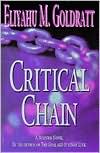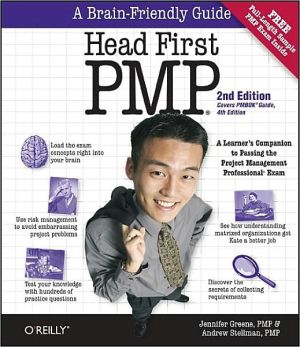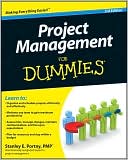The Complete Idiot's Guide to Project Management
Managers will no longer dread the word “project.”\ Fully updated and revised, this guide covers the tools and processes of project management, complying with the standards of the Project Management Institute (PMI) and The Project Management Book of Knowledge (PMBOK). Packed with examples, case studies, and expert opinions, this book includes essential information on implementation strategies, setting up schedules, troubleshooting, and more.\ —Perfect for the new project manager—or the...
Search in google:
Managers will no longer dread the word "project." Fully updated and revised, this guide covers the tools and processes of project management, complying with the standards of the Project Management Institute (PMI) and The Project Management Book of Knowledge (PMBOK). Packed with examples, case studies, and expert opinions, this book includes essential information on implementation strategies, setting up schedules, troubleshooting, and more. -Perfect for the new project manager or the re-learner -New, updated information on software, PMBOK facts, the PMP exam, and integration management
Project Management Power 1Linking Projects to Strategy and Performance Results 3Projects Meet a Business Need 4Viewing Change from a Different Perspective 5A Balance Among Time, Resources, Results, and Perceptions 6Defining Project Success 7The Next Step 10What Does It Mean to Be a Project Manager? 11The Business Connection 11What Are My Responsibilities? 12What Do You Need to Do? 12Learn to Plan and Act 13Focus on the Project's End 13Be a Manager and a Leader 13The Leadership Roles of the Project Manager 14Interpersonal Roles 14Informational Roles 15Decisional Roles 15The Other Business Management Roles 16The Seven Traits of Good Project Managers 16Enthusiasm for the Project 16The Ability to Manage Change Effectively 17A Tolerant Attitude Toward Ambiguity 17Team-Building and Negotiating Skills 17A Customer-First Orientation 17Adherence to the Priorities of Business 18Knowledge of the Industry or Technology 18Be the Best Leader You Can Be 18The Rules of the Project Game 21Universal Project Success Criteria 22Project Failure: The Reasons Are Simple 22Twelve Golden Rules of Project Management Success 23Thou Shalt Gain Consensus on Project Outcomes 24Thou Shalt Build the Best Team You Can 24Thou Shalt Develop a Comprehensive, Viable Plan and Keep It Up-to-Date 25Thou Shalt Determine How Much Stuff You Really Need to Get Things Done 26Thou Shalt Have a Realistic Schedule 26Thou Won't Try to Do More Than Can Be Done 27Thou Will Remember That People Count 27Thou Will Gain the Formal and Ongoing Support of Management and Stakeholders 28Thou Must Be Willing to Change 28Thou Must Keep Others Informed of What You're Up To 29Thou Must Be Willing to Try New Things 29Thou Must Become a Leader 29Keep Your Eyes on the Prize 30The Nine Knowledge Areas of Project Management 31Project Integration Management 32Integration Management as Part of Planning 32Integration Management During Project Execution 33Integration Management of Project Changes 33Project Scope Management 33Project Time Management 34Time and the Schedule 34Controlling the Schedule During Execution 35Project Cost Management 35Financial Issues Outside of Your Control 35Competing for Funds with Other Projects 35Project Quality Management 36Project Human Resource Management 36Organizational Planning 36Staff Acquisition 31Making Them a Team 31Project Communications Management 37Project Risk Management 37Project Procurement Management 38Starting Off on the Right Foot 39The Project Life Cycle 39Project Phases and the Project Life Cycle 40Project Life Cycle versus Product Life Cycle 42A Case Study: All-Star Cable 43The Project 44The Project Manager (That's You) 44Project Definition Phase 45Preparing the Leadership 46How Involved Should the Leadership Be? 47Also Focus on the Project Team 48The Project Definition Phase 49Identifying Stakeholders and Defining Their Roles 51Start by Identifying the Stakeholders 52The Customer 54The Project Sponsor 54The Steering Committee 56Functional Management 57The Working Committee 57Key Stakeholders for the All-Star Cable Case Study 58Working Together: The Magic Success Formula 61Stakeholder Questionnaire 61Scoping Out Project Success 65Start with the Business Case 66What Should Be Included in the Business Case 66Conducting a Feasibility Study 66Developing a Feasibility Study for Movies-on-Demand 67Clear Project Goals Make Sense to Everyone 68The Primary Goals of Every Project 69Six Criteria for Setting Great Goals 70Goals Must Be Specific 70Goals Must Be Realistic 71Goals Must Have a Time Component 71Goals Must Be Measurable 71Goals Must Be Agreed Upon 72Responsibility for Achieving the Goals Must Be Identified 72Establishing Goals Step-by-Step 73Developing the Statement of Work (SOW) 74Putting It Down in Writing 74The Components of the SOW 75Seeing Eye to Eye 77Managing Risks and Constraints 79The Three Types of Risk 80Risk Areas 80Don't Forget Business Risks 81The Ultimate Risk: Acts of God 82Taking Risks Stage by Stage 82Risk Tolerance 83The Basics of Risk Management 84Track Risks with a Risk Log 87Constraints vs. Risks 88Constraints to Consider 88The Budget 89The Schedule 89The People 90The Real World 90Facilities and Equipment 90Risky Business 90The Project Planning Phase 93The Breakdown of Tasks: What Really Needs to Be Done? 95Breaking Your Project into Bite-Sized Pieces 96The Work Breakdown Structure and Your Project 96Organizing the WBS 100Five Steps to the Work Breakdown Structure 102Criteria for Ensuring Quality Work 103Give Yourself Plenty of Time 104Defining Your Deliverables 105Refining the WBS 107The Network Diagram: A Map for Your Project 109What's a Network Diagram? 110Why Do You Need a Network Diagram? 111The WBS and the Network Diagram 111Precedence Relationships in a Project Network 112Concurrent (Parallel) Activities 112Complex Time Relationships for Critical Projects 115When Is Enough Enough? 117Three Major Network Methods and Others You May Encounter 117Circles or Boxes? Who Cares? 118AOA and AON 119Tried and True Networks 120Project Start to Finish: Establishing the Time to Get Things Done 121The Schedule or the Budget: Which Is First? 122The Schedule Synchronizes the Project 122Estimating Time: Your Best Guess at Effort and Duration 125Who Should You Ask? 125Representative Team Members for Each Part of the Project 126Outside Vendors and Service Agencies 126Experienced Managers or Experts 126Management and Other Project Stakeholders 126Weighing the Risk 127A Compromise Between Best and Worst Case 121The Confidence Factor 128Details, Details 129Applying Calendars to a Resource 130Putting It Down on Paper 131Schedule Charting Pros and Cons 131More on Gantt Charts 132Other Considerations as You Build the Schedule 133Revisions and the Schedule 134Learning Takes Time 134The Heat Is On 134Team Member Estimate Errors 134The Just-in-Time Strategy for Scheduling Resources 135What Happens When They Want to Rush Me? 136Determining the Critical Path and its Impact on the Schedule 137How to Determine the Critical Path on Any Project 138Not Just Floating Around 139The Different Views of Critical in Project Management 139Establishing the Critical Path 140Myth or Reality? 141Use the Critical Path Worksheet to Calculate Path and Float 141Normalizing the Schedule 144Loading Up and Leveling Out 145The Reallocation Questions 145Ready for Leveling Out 147Options for Adjusting the Schedule 148Adjusting a Schedule to Meet a Forced Deadline 149Chart the Final Schedule and See If It Works 149Budgeting and Cost Control Options for Your Project 151How to Avoid the Classic Budgeting Mistakes 152Three Levels of Accuracy for Estimating 153Other Sources of Data for Building the Budget 153Direct and Indirect Costs 154Building a Budget 156Get Expert Opinions 157Types of Budgeting Methods 158Bottom-Up Budgeting 159Top-Down Budgeting 159Phased Budgeting 159Refining the Budget 159Adding a Little Insurance Money 161Master Budget Control 161The Time Value of Money 161Cash Flow Analysis 162Payback 162Net Present Value (NPV) 163Internal Rate of Return (IRR) 163Building a Winning Project Team 165The First Step 166Building the Core Project Team 166The Complete Implementation Team: Where Most of the Work on the Project Is Done 168Matching Skills to Tasks on the WBS 169Where Will the People Come From? 171Your Own Staff and Other People from Your Department 171Staff from Other Departments 172Contracting with Consultants and Temporary Agencies 173Hiring and Training New Staff 174Deciding What You Need and Assigning People 175A Survival Resource After the Project Starts 176The Best of the Best: Making Your Selections 176Sometimes You Have to Compromise 177The Problem of Imposed Team Members 177Getting What You Need: Supplies, Equipment, and Other Things 179The Additional Resources You Need 180Planning for Outside Vendors, Contractors, and Suppliers 181Determine What Kind of Contract to Use 182Get an Estimate 182Working with the Purchasing Department 186The Final Steps in Procurement 187Putting It All Together: Getting the Plan Approved 189Reasons to Plan in the First Place 190The Reality Check Before Approval 190What to Do If Discrepancies Appear 192Other Last-Minute Issues to Consider 192Putting It All Together 193Write the Draft Project Plan for the Review Process 196Conduct a Peer Review 196Review the Plan with the Key Stakeholders 197Presenting the Project Plan 198Plan Approval 199From Plan to Action, Finally 200The Execution Phase 203Getting Started on the Right Track 205Always Get Your Own Act Together First! 206Do It Now and Do It Right 206The Formal Kickoff 207It's a Go 207Between Kickoff and Team Meeting: Use the Time Wisely 208The First Project Meeting 209One-on-Ones: The Individual Starting Events 211Setting the Right Expectations 212Information Everyone Needs to Get Started 213Managing Global Projects 214Schedule 215Budget 215Technology 215Quality 216Human Resources 216Procurement 216Leadership: Taking the Bull by the Horns 219The Importance of Establishing Your Leadership 220Wearing the Big Shoes 220A Style That Gets the Job Done 221How to Lead Change 222Building a Case for Change 223Competing with Other Projects for Attention 229Communication Lines 229Where Do Projects Fit Together? 229Critical Path Conflict 230Keep Your Project Front and Center 230Leading a Technical Project When You Don't Have Expertise 231Being All Things to All People 232What an Organization! 233No Easy Task, but Someone Has to Organize These People 233The Human Drama: Personality, Politics, and Corporate Culture 234Give Them a Script 235Avoid Casting Catastrophes 235The Proud, the Few...the Project Team 235On Becoming a Team: The Basic Ways to Organize People 236The Functional Project Organization 237The Pure-Project Organization 239The Matrix Organization 241The Mixed Organization 244Which Structure Should You Use? 245Using a RACI Chart 245Matching the Organization to Fit the Project 246Managing the Working Committee 247Operating Guidelines: Setting Up to Get Things Done 249The Project Processes in Each Phase 250Project Processes vs. Project Procedures 251Project Processes and the Plan-Do-Check-Act Cycle 251The Things That Need to Get Done 252Handling Business Process Changes 252Start with the Project Team 253Now It's Time for the Working Committee 254Making the Decision 255Escalating the Decision 255Set Up a Work Authorization System 256Administrative Procedures That Won't Hurt 256The Reports You May Need 257Simple Forms to Create Useful Reports 258Every Report Needs a Purpose 258Ask Two Final Questions Before You Start 259Why You Should Keep a Project Diary 259The Bottom Line 260Making Your Communications Count 261The Basics of Communications: It's All About Perceptions 262What Does a Communication Plan Look Like? 263Stakeholder Analysis 263Sensitivity Analysis 264Information Needs 265Media Requirements 265Delivery Personnel and Power Bases 266Timing Requirements 267Common Definitions 267Feedback Loops 268Macro and Micro Barriers 268Jargon and Acronyms 269Execute the Communications Plan 269Communications and Leadership 270Developing Effective Messages 270Listening Is Part of Communicating 271The Controlling Processes 273Monitoring and Controlling Schedules and Expenses 275Taking Charge and Getting Control 276Success Criteria for Project Control 276What Should You Monitor? 278What Monitoring Should Accomplish 280Using Earned Value Analysis to Determine Project Status 280Using Gantt Charts to Control Your Project 282The Project Review Meeting as a Control Process 282The Project Audit 283The Project Peer Review 284Monitoring and Controlling the Budget 284Putting It All Together 285Preparing Operations for the Project Deliverables 289Five Requirements for Operations Integration 290Create and Communicate the Conclusion 290Have the Skills to Use the Deliverable 290Give Users Incentives 291Help Users/Operators Make the Transition 291Let Stakeholders Know the Schedule 292Developing the Training Plan 292Symptoms That Operations Is Not Ready 294Overcoming Resistance to Change 295Fear 295Feelings of Powerlessness 296Discomfort 297Absence of Self-Interest 297Changes, Changes, and More Changes 299Develop a Process for Change Control 300What Might a Change Process Look Like? 301The Rules of Change Control 302Understanding and Estimating the Impact of Changes 304The Balancing Act 304Comparing Changes with Trade Off Analysis 307Communicating a Scope Change 307When Conflicts Occur 308Create an Issues Log 309Quality Management: Making It the Best It Can Be 311What Exactly Does Quality Mean in a Project? 312Planning for Quality Is the Starting Point 312Quality Planning Tools and Techniques 313Cost/Benefit Analyses 313Benchmarking 314Cause-and-Effect Diagrams 314Quality Assurance: The Real Proof 316Quality Control: It's All About Results 317Common Project Problems: Get Them Before They Get You 319Recognizing All Problems, Large and Small 320The Floating Start Date 320There's Not Enough Time, or They Need It Faster 321The 90-Percent-Done Syndrome 322Moving Target Objectives 323The Key Person Always Quits 323Costs Spiral out of Control 324The Staff Has More Enthusiasm Than Talent 324The Impossible Remains Impossible 325Politics, Politics, and More Politics 326Management by Best-Seller 326Taking Care of Yourself to Remain Sane 327A Parable of Last Resort 327The Close-Out Phase 329Will the Last One Out Please Turn Off the Lights? 331Is There Life After Project Termination? 332Why Is a Close-Out Phase Necessary? 332The Final Shutdown 332Closing a Small Project 334Closing a Large Project 334Write Out Your Lessons Learned 335Some Additional Details for Project Shutdown 336The After-Implementation Review 339Three Ways to Release a Workforce 339Give It Up! 340The Final Evaluation: The Short and Long of It 343Evaluating Your Project 343Meet with Core Team Members 344Compare Goals to Achievements 344Writing the Final Report 345Packaging Options for the Report 347The Political Impact of Final Reports 348Who Accomplished What and How Well? 348The Bottom Line and You 349The Organization and Tools to Make Project Management Prosper 351The Project-Enabled Organization 353Understanding the Benefits of Formalizing Project Management 354Is Your Organization Ready to Be Projectized? 354Define the Organizational Boundaries First 356Now Come the Standards 358Where Do Standards Come From? 359Establish a Life Cycle Standard 359Manage Projects Like an Asset for Your Future 361Putting a Project Office in Place to Support the System 362In the End, It's Leadership That Makes It Work 363Software for All Projects Great and Small 365Software That Simplifies the Details 366What Can Project Management Programs Do? 366The Virtual World of the Project Needs Virtual Tools 369The Power of Networking 370So What's in It for Me? 370Simple vs. Complex Projects and the Software They Need 371The Types of Project Management Programs 371Single-Project Programs 372Corporate-Level Programs 372Mega-Project Programs 373How Do You Choose? 373Pricing 373Total Number of Activities and Resources 374Direct Cost Assignment and Tracking 374Resource Scheduling and Leveling 374Flexible Calendar Functions 374Import and Export Functions 375Infrastructure Requirements 376Documentation and Support for the Program 376Reputation of the Product Manufacturer 376Word-of-Mouth Experience 376Technical Support 377Things Project Management Software Can't Do 377Go Get Yourself Some! 379AppendixWeb Resources for Project Managers 381Index 383
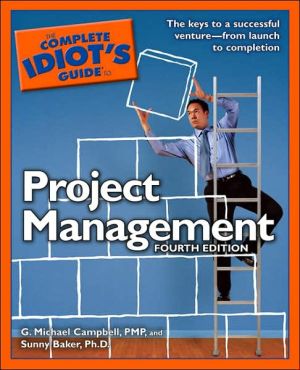
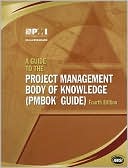
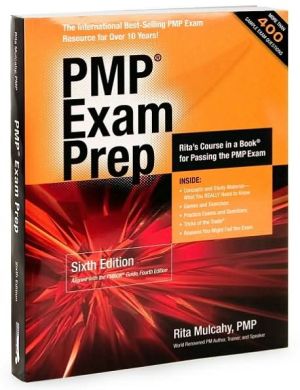

![Microsoft Office Project 2007 Step by Step [With CDROM] Microsoft Office Project 2007 Step by Step [With CDROM]](/application/data/covers/30/57/9780735623057.jpg)
